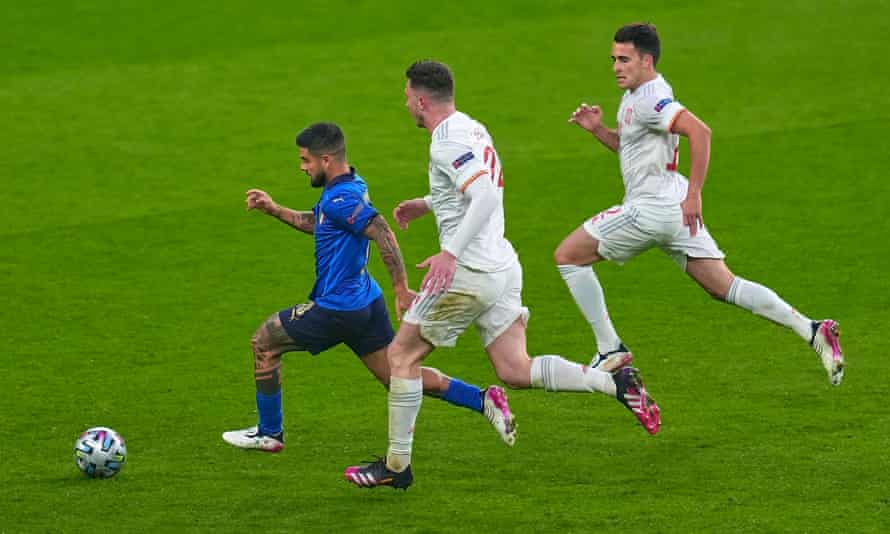Tactical battle: where the Euro 2020 final will be won and lost
There is a tide in the affairs of men
Before every game, the biggest question has been whether Gareth Southgate should go with a back three or a back four. Block in the opposing wing-/full-backs or give them a defensive problem? There is no definitive answer.
Against Germany Southgate opted for the more cautious option and, after an hour or so of grind, was vindicated. Against Ukraine, it was all about making the wing-backs defend, a plan that worked perfectly. Against Denmark it was the back four again and, despite a wobbly 15 minutes in the first half, Southgate was rewarded. But very few issues in football are discrete; the answer to the flanks lies often in midfield.
It’s no good playing a game of chicken on the flanks if you’re not dominating the centre, or the wingers will end up spending most of their time tracking back. Against Germany, whichever two of Toni Kroos, Leon Goretzka and Ilkay Gündogan played, plus Thomas Müller and Kai Havertz dropping deep, had the potential to starve England of the ball and so Southgate took the more cautious option of a back three. Against Ukraine and Denmark, he was confident England could get a grip on midfield. There were anxious moments but, by the second half, it was clear the the gamble had worked.
Against Italy the issue is slightly different given they will be playing a back four rather than a back three as Germany, Denmark and Ukraine did. Spain may have controlled possession against Italy’s midfield three of Jorginho, Marco Verratti and Nicolò Barella, but England, for all their recent progress, cannot pass like Luis Enrique’s Spain. The knockout game that may offer more of a template is the last-16 match in which Italy struggled to impose themselves on Austria, who played a back three against them.
… his left hand, which did flame and burn like 20 torches join’d …
In the first part of the tournament, Italy’s prime attacking threat came down the left with the link-up between Leonardo Spinazzola and Lorenzo Insigne. Even after Spinazzola’s injury against Belgium and his replacement with Emerson Palmieri, that continues to be the case, even if Emerson’s relationship with Insigne – as is only natural given the lack of recent time on the pitch together – is not quite so slick.
Italy attack 24% more often down the left than the right, so there must be some kind of check on Emerson, not just to stop his own incursions (and he did hit the woodwork against Spain in the semi-final) but to prevent the link-up that in turn makes Insigne more dangerous.

That could be Bukayo Saka, who after a nervous start played well against Denmark. Or, if the preference is for a 3-4-3, it could be Mason Mount, who played the role to perfection in the Nations League win over Belgium last year. A back three would also in effect shunt Kyle Walker into a position from which he could pick up Insigne’s drifts inside, far more naturally than any player would in the 4-2-3-1/4-3-3 used against Denmark.
Why all these gliding ghosts?
There was a lot of talk in the first week of the tournament about Harry Kane’s habit of dropping deep and whether that was beneficial for England or simply caused congestion in the middle. After his performance against Denmark, that debate surely is settled. So long as there is at least one wide player to run beyond him, Kane’s mobility is a major asset and his link-up with Saka and Sterling was a major weapon (which may be an argument in favour of the 4-3-3).
But it was notable how Spain’s use of Dani Olmo as a false 9 unsettled Leonardo Bonucci and Giorgio Chiellini, while Kane’s movement troubled a Juventus defence including Chiellini in the Champions League in 2018.
If it is a 3-4-3, Kane may also have a role to play dropping deep to try to prevent Jorginho functioning as a metronome at the back of the Italian midfield – along with, presumably, Kalvin Phillips pushing forward. With a pass completion rate of 92.9%, the highest of any midfielder to have started more than three games at this Euros, Jorginho is key to setting Italy’s rhythm and England will need to find a way of disrupting him. If it is a back four, that job will probably go to Mount.
The noise of battle hurtled in the air
The last two games have seen a huge improvement from England in terms of set-piece danger, with Harry Maguire a major threat. Even against Denmark’s towering back three, he won three headers in a row from set plays, the second of which brought a brilliant stretching save from Kasper Schmeichel.
No player from a side that reached the last eight has won more aerial duels per game than Maguire and, while Bonucci and Chiellini have the experience and wherewithal to cope, Italy have won a lower percentage of their aerial battles in this tournament than any side other than Finland and Hungary.
As a team, they are not physically imposing and that may offer an opportunity to England, who have created more chances from set plays than any other team in the Euros. Mount and Luke Shaw are both in the top 10 players for chance creation from set pieces, with Trippier not far behind.
Subscribe To Our Newsletter
-
How to get a free jersey
- How to get Pcs free jerseys Feedback Customer Reviews About Us Contact Us News FAQ
-
User Center
- Forget Password My Orders Tracking Order My Account Register
-
Payment & Shipping
- Customs & Taxes Locations We Ship To Shipping Methods Payment Methods
-
Company Policies
- Return Policy Privacy Policy Terms of Use Infringement Policy

